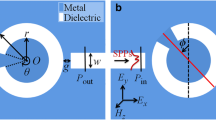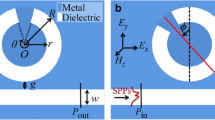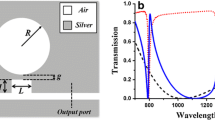Abstract
We propose and investigate left- or right-handed sectorial-ring cavity resonator coupled to metal-insulator-metal plasmonic waveguide. This resonator has the advantages of realizing simple, compact, asymmetrical, multiple, and controllable or tunable cavity, which is a novel plasmonic nanofilter or nanosensor. According to the two-dimensional simulation, the results indicate that the left- or right-handed resonator is the identical effect, and two resonance modes appear in the transmission spectrum of the novel system. When the refractive index (n) of the dielectric, the width (ws) and center arc length (lC) (namely central angle (θ), outer radius (R) and inner radius (r)) of the cavity, and the gap distance (g) between cavity and waveguide are fixed and unfixed, the transmission spectrum is highly controlled with various θ, R and r, and tuned by adjusting the n, (R − r), θ, (R + r) or g, respectively. The coupled mode theory is employed to elucidate the spectral characteristic, which is in good agreement with the numerical simulation. It provides a promising way for realization of controllable or tunable transmission spectrum and for optimization of prospective structure size, and has potential application in nanoscale optical devices and integrated optics devices. It demonstrates a practical approach to design optical devices, which will satisfy different fabricating demands in future.







Similar content being viewed by others
References
W.L. Barnes, W.A. Murray, J. Dintinger, E. Devaux, T.W. Ebbesen, Surface plasmon polaritons and their role in the enhanced transmission of light through periodic arrays of subwavelength holes in a metal film. Phys. Rev. Lett. 92, 107401 (2004)
E. Ozbay, Plasmonics: merging photonics and electronics at nanoscale dimensions. Science 311, 189–193 (2006)
S.A. Maier, P.G. Kik, H.A. Atwater, S. Meltzer, E. Harel, B.E. Koel, A.A.G. Requicha, Local detection of electromagnetic energy transport below the diffraction limit in metal nanoparticle plasmon waveguides. Nat. Mater. 2, 229–232 (2003)
D.F.P. Pile, T. Ogawa, D.K. Gramotnev, Y. Matsuzaki, K.C. Vernon, K. Yamaguchi, T. Okamoto, M. Haraguchi, M. Fukui, Two-dimensionally localized modes of a nanoscale gap plasmon waveguide. Appl. Phys. Lett. 87, 261114 (2005)
G. Veronis, S.H. Fan, Modes of subwavelength plasmonic slot waveguides. J. Lightwave Technol. 25, 2511–2521 (2007)
W. Cai, W. Shin, S. Fan, M.L. Brongersma, Elements for plasmonic nanocircuits with three-dimensional slot waveguides. Adv. Mater. 22, 5120–5124 (2010)
Z. He, H. Li, S. Zhan, B. Li, Z. Chen, H. Xu, π-Network transmission line model for plasmonic waveguides with cavity structures. Plasmonics 10, 1581–1585 (2015)
Z. Chen, H. Li, S. Zhan, B. Li, Z. He, H. Xu, M. Zheng, Tunable high quality factor in two multimode plasmonic stubs waveguide. Sci. Rep. 6, 24446 (2016)
K. Tanaka, M. Tanaka, T. Sugiyama, Simulation of practical nanometric optical circuits based on surface plasmon polariton gap waveguides. Opt. Express 13, 256–266 (2005)
L. Liu, Z. Han, S. He, Novel surface plasmon waveguide for high integration. Opt. Express 13, 6645–6650 (2005)
B. Li, H. Li, L. Zeng, S. Zhan, Z. He, Z. Chen, H. Xu, Theoretical analysis and applications in inverse T-shape structure. J. Opt. Soc. Am. A 33, 811–816 (2016)
Z. He, H. Li, B. Li, Z. Chen, H. Xu, M. Zheng, Theoretical analysis of ultrahigh figure of merit sensing in plasmonic waveguides with a multimode stub. Opt. Lett. 41, 5206–5209 (2016)
Z. Chen, H. Li, Z. He, H. Xu, M. Zheng, M. Zhao, Multiple plasmon-induced transparency effects in a multimode-cavity-coupled metal-dielectric-metal waveguide. Appl. Phys. Express 10, 092201 (2017)
M. Zheng, H. Li, H. Xu, Z. He, Z. Chen, M. Zhao, Filtering property based on ultra-wide stopband in double sector/sectorial-ring stub resonator coupled to plasmonic waveguide. IEEE Photon. J. 9, 2201308 (2017)
M. Zhao, H. Li, Z. He, Z. Chen, H. Xu, M. Zheng, Novel oscillator model with damping factor for plasmon induced transparency in waveguide systems. Sci. Rep. 7, 10635 (2017)
Q. Zhang, X. Huang, X. Lin, J. Tao, X. Jin, A subwavelength coupler-type MIM optical filter. Opt. Express 17, 7549–7554 (2009)
B. Yun, G. Hu, Y. Cui, Resonant mode analysis of the nanoscale surface plasmon polariton waveguide filter with rectangle cavity. Plasmonics 8, 267–275 (2013)
H. Lu, X. Liu, Y. Gong, L. Wang, D. Mao, Multi-channel plasmonic waveguide filters with disk-shaped nanocavities. Opt. Commun. 284, 2613–2616 (2011)
Z. Han, Ultracompact plasmonic racetrack resonators in metal-insulator-metal waveguides. Photonics Nanostruct. 8, 172–176 (2010)
A. Hosseini, Y. Massoud, Nanoscale surface plasmon based resonator using rectangular geometry. Appl. Phys. Lett. 90, 181102 (2007)
X. Peng, H. Li, C. Wu, G. Cao, Z. Liu, Research on transmission characteristics of aperture-coupled square-ring resonator based filter. Opt. Commun. 294, 368–371 (2013)
T. Holmgaard, Z. Chen, S.I. Bozhevolnyi, L. Markey, A. Dereux, Dielectric-loaded plasmonic waveguide-ring resonators. Opt. Express 17, 2968–2975 (2009)
A.W. Clark, A.K. Sheridan, A. Glidle, D.R.S. Cumming, J.M. Cooper, Tuneable visible resonances in crescent shaped nano-split-ring resonators. Appl. Phys. Lett. 91, 093109 (2007)
E.D. Palik, Handbook of Optical Constants of Solids (Academic, Boston, 1985)
H.A. Haus, Waves and Fields in Optoelectronics. (Prentice-Hall, Upper Saddle River, 1984)
S. Zhan, H. Li, G. Cao, Z. He, B. Li, H. Xu, Theoretical analysis and applications on nano-block loaded rectangular ring. J. Opt. Soc. Am. A 31, 2263–2267 (2014)
Z.F. Yu, G. Veronis, S.H. Fan, M.L. Brongersma, Gain-induced switching in metal-dielectric-metal plasmonic waveguides. Appl. Phys. Lett. 92, 041117 (2008)
M. Zheng, H. Li, H. Xu, M. Zhao, C. Xiong, B. Zhang, Tunable and selective transmission based on multiple resonance modes in side-coupled sectorial-ring cavity waveguide. Plasmonics. https://doi.org/10.1007/s11468-018-0817-0
M. Zheng, H. Li, Z. Chen, H. Xu, M. Zhao, C. Xiong, Transmission performance based on plasmonic waveguide coupled with sectorial-ring stub resonator. IEEE Photonics Technol. Lett. 30, 415–418 (2018)
S.I. Bozhevolnyi, J. Jung, Scaling for gap plasmon based waveguides. Opt. Express 16, 2676–2684 (2008)
S. Zhan, H. Li, G. Cao, Z. He, B. Li, H. Yang, Slow light based on plasmon-induced transparency in dual-ring resonator-coupled MDM waveguide system. J. Phys. D 47, 205101 (2014)
M. Zheng, H. Li, Z. Chen, Z. He, H. Xu, M. Zhao, Compact and multiple plasmonic nanofilter based on ultra-broad stopband in partitioned semicircle or semiring stub waveguide. Opt. Commun. 402, 47–51 (2017)
Y. Fan, N. Shen, T. Koschny, C.M. Soukoulis, Tunable terahertz meta-surface with graphene cut-wires. ACS Photonics 2, 151–156 (2015)
Y. Fan, N. Shen, F. Zhang, Z. Wei, H. Li, Q. Zhao, Q. Fu, P. Zhang, T. Koschny, C.M. Soukoulis, Electrically tunable Goos-Hanchen effect with graphene in the terahertz regime. Adv. Opt. Mater. 4, 1824–1828 (2016)
Y. Fan, N. Shen, F. Zhang, Q. Zhao, Z. Wei, P. Zhang, J. Dong, Q. Fu, H. Li, C.M. Soukoulis, Photoexcited graphene metasurfaces: significantly enhanced and tunable magnetic resognances. ACS Photonics 5, 1612–1618 (2018)
W. Zhu, R. Yang, Y. Fan, Q. Fu, H. Wu, P. Zhang, N. Shen, F. Zhang, Controlling optical polarization conversion with Ge2Sb2Te5-based phase-change dielectric metamaterials. Nanoscale 10, 12054–12061 (2018)
Acknowledgements
This work was supported by the National Natural Science Foundation of China under Grant no. 61275174 and the Postgraduate Technology Innovation Project of Central South University under Grant no. 2017zzts062.
Author information
Authors and Affiliations
Corresponding author
Additional information
Publisher’s Note
Springer Nature remains neutral with regard to jurisdictional claims in published maps and institutional affiliations.
Rights and permissions
About this article
Cite this article
Zheng, M., Zhao, M., Xiong, C. et al. Spectral characteristic based on sectorial-ring cavity resonator coupled to plasmonic waveguide. Appl. Phys. B 125, 53 (2019). https://doi.org/10.1007/s00340-019-7164-5
Received:
Accepted:
Published:
DOI: https://doi.org/10.1007/s00340-019-7164-5




